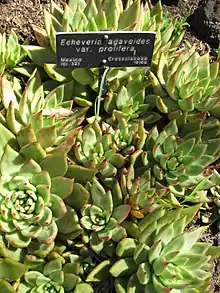Echeveria agavoides
Echeveria agavoides, or lipstick echeveria, is a species of flowering plant in the family Crassulaceae, native to rocky areas of Mexico, notably the states of San Luis Potosí, Hidalgo, Guanajuato and Durango.
| Echeveria agavoides | |
|---|---|
 | |
| Scientific classification | |
| Kingdom: | Plantae |
| Clade: | Tracheophytes |
| Clade: | Angiosperms |
| Clade: | Eudicots |
| Order: | Saxifragales |
| Family: | Crassulaceae |
| Genus: | Echeveria |
| Species: | E. agavoides |
| Binomial name | |
| Echeveria agavoides | |
| Synonyms[1] | |
| |

Description
Echeveria agavoides is a small, stemless succulent plant, 8–12 centimetres (3.1–4.7 in) tall, with a rosette of leaves 7–15 centimetres (2.8–5.9 in) in diameter. It is often solitary, but old plants in good condition grow offsets. The leaves are green, triangular, thicker (6 mm) and more acute than the other echeverias - hence the explanation of their name agavoides, "looking like an agave".[2] Some varieties with bright light have reddish (or bronze) tips and some forms have slightly red to very red margins. The inflorescences in summer appear on slender, single-sided cymes up to 50 centimetres (20 in) long. The flowers are pink, orange or red, the petals tipped with dark yellow.[3]
Etymology
Echeveria is named for Atanasio Echeverría y Godoy, a botanical illustrator who contributed to Flora Mexicana.[4]
Taxonomy
Varieties:
- Echeveria agavoides var. corderoyi
- Echeveria agavoides var. multifida
- Echeveria agavoides var. prolifera
Cultivars:
- 'Lipstick', with red leaf edges
- 'Ebony', with dark brown edges, almost burgundy
- 'Aquamarine', with icy emerald-green leaves
Cultivation
As with most echeverias, E. agavoides may be harmed by moisture and prefers mineral soils, growing best in light and even direct sunshine, which aids flowering. In order to flower, plants need rest in the winter, without water and in a cold place - but not less than 5 °C (41 °F). In temperate regions they must be kept indoors during winter, but may be placed outside during the summer months.[3]
This plant has gained the Royal Horticultural Society's Award of Garden Merit.[5]
Many hybrids have been created to obtain more brightly colored flowers or leaves.
The easiest methods of propagation are leaf cuttings and division of older plants. It propagates easily from cutting the stem although propagation from leaves can be more difficult. In order to propagate, one must take a sharp sterilized knife or scissors to cut away at the stem or leaves. Time must pass to allow for callousing before replanting. [6]
References
- "Echeveria agavoides Lem". Plants of the World Online. Royal Botanic Gardens, Kew. Retrieved 2020-03-28.
- Harrison, Lorraine (2012). RHS Latin for gardeners. United Kingdom: Mitchell Beazley. p. 224. ISBN 9781845337315.
- RHS A-Z encyclopedia of garden plants. United Kingdom: Dorling Kindersley. 2008. p. 1136. ISBN 978-1405332965.
- Gledhill, David (2008). "The Names of Plants". Cambridge University Press. ISBN 9780521866453 (hardback), ISBN 9780521685535 (paperback). pp. 39, 149
- "RHS Plant Selector - Echeveria agavoides". Retrieved 18 June 2013.
- "This Echeveria shows off when it's been happily "stressed."". Succulents and Sunshine. 2019-02-09. Retrieved 2019-10-23.
- Attila Kapitany, (2009). Knowing Echeverias, Cactus and Succulent Journal, Volume 81 Issue 2.
External links
| Wikimedia Commons has media related to Echeveria agavoides. |
| Wikispecies has information related to Echeveria agavoides. |